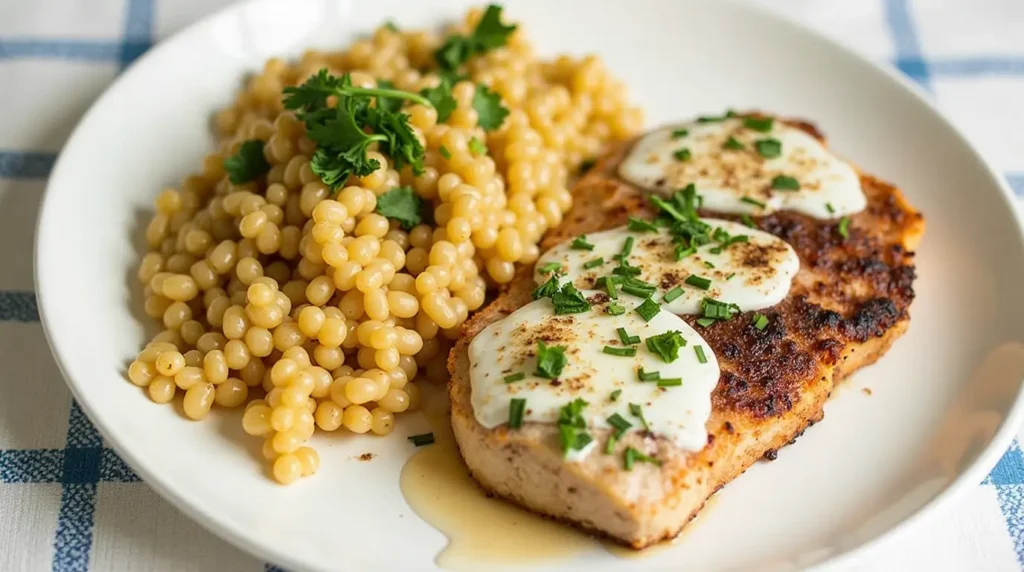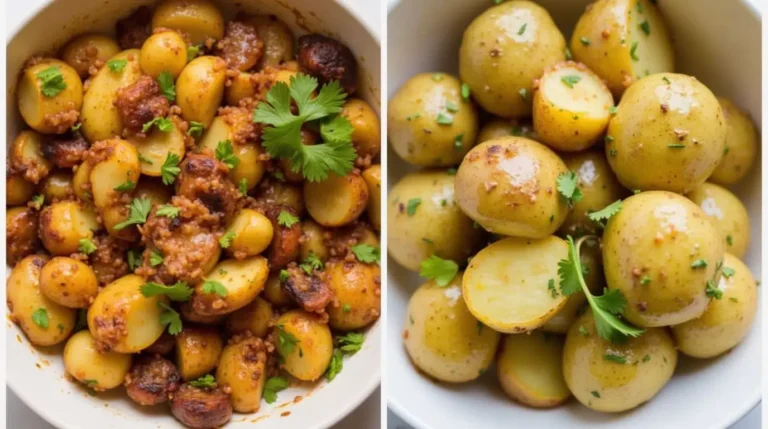Introduction
Gut health plays a crucial role in our overall well-being, affecting everything from digestion to our immune system, mood, and even energy levels. For those dealing with digestive issues such as Irritable Bowel Syndrome (IBS) or other gut-related discomforts, the low FODMAP diet has become a popular and effective solution. This diet involves eliminating foods that are high in fermentable carbohydrates (FODMAPs), which can cause bloating, gas, and other digestive issues.
In this post, we’ll explore 5 delicious low FODMAP dinner recipes that not only taste amazing but also help support your gut health. If you’ve been struggling with digestive discomfort or simply want to maintain a healthy digestive system, these recipes are perfect for you. Whether you’re new to the low FODMAP diet or have been following it for a while, these easy-to-make meals will leave you feeling satisfied and nourished.
Table of Contents

Understanding the Low FODMAP Diet and Its Benefits
What Are FODMAPs?
FODMAP stands for Fermentable Oligosaccharides, Disaccharides, Monosaccharides, and Polyols. These are short-chain carbohydrates that can be poorly absorbed in the small intestine. When consumed in large quantities, they can ferment in the gut, producing gas and causing bloating, cramps, and other digestive symptoms. People with conditions like IBS (Irritable Bowel Syndrome) are particularly sensitive to these carbohydrates.
Some common high FODMAP foods include:
- Oligosaccharides: Found in wheat, rye, onions, and garlic.
- Disaccharides: Found in dairy products like milk and yogurt (due to lactose).
- Monosaccharides: Found in fruits like apples, pears, and mangoes (due to excess fructose).
- Polyols: Found in stone fruits like cherries, peaches, and plums, as well as artificial sweeteners.
How the Low FODMAP Diet Supports Gut Health
The low FODMAP diet works by reducing the intake of these problematic carbohydrates. By following this diet, many people with IBS or digestive issues experience a significant reduction in symptoms like bloating, abdominal pain, and diarrhea. It’s often recommended to follow a three-phase process:
- Elimination: Remove all high FODMAP foods from your diet for 4-6 weeks.
- Reintroduction: Gradually reintroduce high FODMAP foods to determine which ones cause symptoms.
- Personalization: Develop a long-term eating plan that includes the foods that are safe for you to consume.
Benefits Beyond Digestion
While the primary focus of the low FODMAP diet is digestive health, there are several additional benefits that can improve your overall well-being. By reducing the intake of FODMAPs, you may experience:
- Improved energy levels
- Better sleep quality
- Enhanced mood and mental clarity
- Reduction in bloating and discomfort
- A healthier gut microbiome
5 Easy and Delicious Low FODMAP Dinner Recipes
Recipe 1: Grilled Chicken with Quinoa and Veggies
This recipe is a simple yet satisfying dinner that combines lean protein, fiber-rich quinoa, and a variety of low FODMAP vegetables.
Ingredients:
- 2 boneless, skinless chicken breasts
- 1 cup quinoa (rinsed)
- 1 zucchini, sliced
- 1 bell pepper, sliced
- 1 tablespoon olive oil
- 1 teaspoon dried oregano
- Salt and pepper to taste
Instructions:
- Preheat your grill or stovetop pan.
- Season the chicken breasts with olive oil, oregano, salt, and pepper. Grill for about 6-7 minutes on each side until cooked through.
- In a saucepan, bring 2 cups of water to a boil. Add the quinoa, cover, and simmer for about 15 minutes or until the water is absorbed.
- Meanwhile, sauté the zucchini and bell pepper in olive oil until tender, about 5-7 minutes.
- Serve the grilled chicken over a bed of quinoa and sautéed vegetables for a complete and gut-friendly meal.
Benefits for Gut Health:
- Chicken is a lean protein that’s easy on the digestive system.
- Quinoa is a gluten-free, high-fiber grain that supports digestion.
- Zucchini and bell peppers are both low in FODMAPs and rich in vitamins.
Recipe 2: Shrimp and Spinach Stir-Fry
This shrimp stir-fry is packed with gut-friendly ingredients like shrimp, spinach, and olive oil.
Ingredients:
- 1 lb shrimp, peeled and deveined
- 3 cups spinach, fresh
- 1 tablespoon garlic-infused olive oil (use oil, not fresh garlic)
- 1 tablespoon tamari or gluten-free soy sauce
- Salt and pepper to taste
Instructions:
- Heat the garlic-infused olive oil in a skillet over medium heat.
- Add the shrimp and cook for 2-3 minutes on each side until pink and opaque.
- Add the spinach to the pan and sauté for 1-2 minutes until wilted.
- Stir in tamari sauce, season with salt and pepper, and serve.
Benefits for Gut Health:
- Shrimp is a high-protein, low-FODMAP food that’s gentle on the gut.
- Spinach is a fiber-rich, gut-nourishing vegetable that’s also low in FODMAPs.
- Garlic-infused olive oil provides flavor without the FODMAPs of fresh garlic.
Recipe 3: Beef Skewers with a Garlic-Infused Oil
Beef skewers make a great low FODMAP dinner option when paired with a healthy, garlic-infused oil dressing.
Ingredients:
- 1 lb beef sirloin, cut into cubes
- 1 tablespoon garlic-infused olive oil
- 1 tablespoon rosemary, dried
- 1 tablespoon balsamic vinegar
- Salt and pepper to taste
Instructions:
- Preheat your grill to medium-high heat.
- Thread the beef cubes onto skewers.
- Brush with garlic-infused olive oil, rosemary, balsamic vinegar, salt, and pepper.
- Grill for 5-6 minutes per side until the beef reaches your desired level of doneness.
- Serve with a side of sautéed vegetables or a simple salad.
Benefits for Gut Health:
- Beef provides a rich source of protein that supports muscle health and is easily digestible.
- Garlic-infused olive oil provides a savory flavor without triggering digestive distress.
- Rosemary adds anti-inflammatory properties and digestive support.
Recipe 4: Spaghetti Squash with Tomato Basil Sauce
This gluten-free, low FODMAP alternative to traditional pasta is a great way to enjoy comfort food without compromising gut health.
- 1 medium spaghetti squash
- 1 cup homemade tomato basil sauce (ensure it’s made without onions or garlic)
- Fresh basil leaves for garnish
- Salt and pepper to taste
Instructions:
- Preheat the oven to 400°F (200°C).
- Slice the spaghetti squash in half and remove the seeds.
- Roast the squash cut-side down for 40-45 minutes, until tender.
- Scrape the flesh with a fork to create spaghetti-like strands.
- Top with the tomato basil sauce and fresh basil leaves.
Benefits for Gut Health:
- Spaghetti squash is a low-FODMAP, fiber-rich vegetable that’s easy to digest.
- Tomato sauce made without garlic and onions supports gut health by avoiding common irritants.
- Fresh basil adds anti-inflammatory properties.
Recipe 5: Salmon with Roasted Carrots and Mashed Potatoes
A classic and easy-to-make dinner, salmon provides healthy fats while roasted carrots and mashed potatoes make for a comforting side dish.
Ingredients:
- 2 salmon fillets
- 4 large carrots, peeled and sliced
- 2 medium potatoes, peeled and boiled
- 2 tablespoons olive oil
- Salt and pepper to taste
Instructions:
- Preheat your oven to 375°F (190°C).
- Place the carrots on a baking sheet, drizzle with olive oil, and season with salt and pepper. Roast for 25-30 minutes until tender.
- While the carrots roast, boil the potatoes until soft, then mash them with a little olive oil, salt, and pepper.
- Sear the salmon in a pan with olive oil for 3-4 minutes on each side until crispy and cooked through.
- Serve the salmon with roasted carrots and mashed potatoes for a satisfying, low FODMAP meal.
Benefits for Gut Health:
- Salmon is rich in omega-3 fatty acids, which are anti-inflammatory and support digestive health.
- Carrots are an easy-to-digest vegetable that’s low in FODMAPs.
- Mashed potatoes provide a soft, comforting carb that’s gentle on the stomach.

Key Ingredients for Low FODMAP Dinners
When following a low FODMAP diet, it’s essential to choose ingredients that are both nutrient-dense and gentle on the digestive system. Some great options include:
Low FODMAP Vegetables
- Zucchini
- Bell peppers
- Carrots
- Spinach
- Tomatoes
Gut-Friendly Proteins
- Chicken
- Turkey
- Beef (lean cuts)
- Salmon
- Shrimp
Healthy Fats
- Olive oil
- Avocado (in moderation)
- Coconut oil
- Nuts (e.g., almonds, macadamias)
Practical Tips for Cooking Low FODMAP Meals
How to Avoid Common High FODMAP Ingredients
Many common kitchen ingredients, like garlic, onions, and dairy products, are high in FODMAPs. When cooking low FODMAP meals, it’s important to avoid or substitute these ingredients. For example:
- Use garlic-infused oil instead of fresh garlic.
- Opt for lactose-free dairy or dairy alternatives like almond milk.
- Replace wheat flour with gluten-free options like rice flour or quinoa.
Meal Prep for Busy Days
Meal prepping is key to staying on track with a low FODMAP diet. Cook large batches of safe ingredients (like grilled chicken, quinoa, and roasted vegetables) and store them in the fridge for easy meals throughout the week.
Simplifying Low FODMAP Cooking
Stick to simple, whole foods that are naturally low FODMAP. This makes meal planning much easier, ensuring you always have gut-friendly options on hand.
How the Low FODMAP Diet Can Improve Overall Well-Being
Relieving IBS Symptoms
A low FODMAP diet is specifically designed to reduce IBS symptoms like bloating, abdominal pain, and diarrhea. By eliminating high FODMAP foods and slowly reintroducing them, individuals can identify specific triggers and manage their condition more effectively.
Supporting Digestive Enzymes
Certain low FODMAP foods, such as lean proteins, healthy fats, and fiber-rich vegetables, support digestive enzyme production and promote healthy digestion.
Enhancing Your Gut Microbiome
The low FODMAP diet can help optimize the balance of gut bacteria by reducing the intake of fermentable carbs. This leads to a healthier gut microbiome, which is crucial for overall digestive health.
Conclusion
A low FODMAP diet doesn’t have to mean bland, boring meals. These 5 delicious dinner recipes are just a taste of what you can enjoy while following a gut-friendly eating plan. By choosing the right ingredients and cooking with care, you can support your digestive health while enjoying satisfying, flavorful meals. Give these recipes a try and feel the difference in your gut health!






